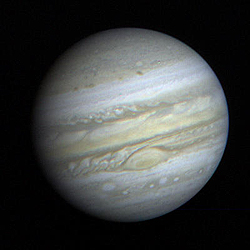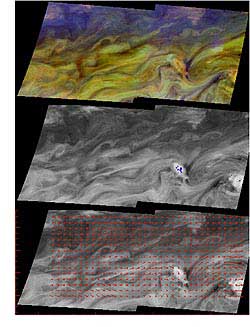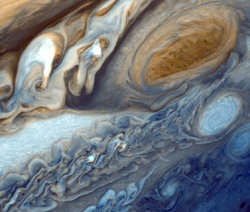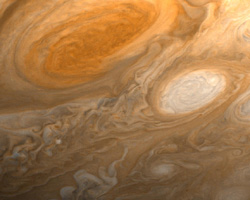|
For 400 years scientists have puzzled over the swirling and
turbulent clouds on Jupiter. Now the giant planet's secret is out.
Based
on information provided by Cornell University
Anvil clouds
tower more than 30 miles high. Amid the gathering gloom, 100 mph
winds whip clouds across the sky. Painfully brilliant lightning
flashes punctuate the tumult. Meanwhile, clouds from another giant
storm dump several inches of water, every day, over an area more
than 600 miles across.
Given the supernatural severity of these storms, and thunderheads
three times higher than we see on our planet, we are clearly not
on the Earth. Welcome to the super-storms of Jupiter.
The giant planet of the Solar System is as different from the Earth
as any planet could be. Jupiter is big enough to fit 1300 Earths
inside, and it is made of gas and liquid throughout. Yet some of
its storms are remarkably similar - though vaster in scale - to
thunderstorms on Earth. Even stranger, the latest results from NASA's
Galileo spacecraft reveal that these storms are powered in a completely
different way from terrestrial thunderstorms.
"There is a lot of activity we see on Jupiter that we see on Earth,"
says Peter J. Gierasch, professor of astronomy at Cornell University.
Along with colleagues from Cornell, the California Institute of
Technology and NASA's Jet Propulsion Laboratory, Gierasch has been
studying views of Jupiter taken by Galileo on May 4, 1999. He continues:
"We see jet streams, large cyclonic elements, large anti-cyclonic
elements and many elements of unpredictability and turbulence."

NASA
The
giant planet is 1300 times larger than Earth
|
Of all the tempest-tossed storms in the Solar System, the astronomers
chose to examine an area west of the giant planet's Great Red Spot,
in a region known as the South Equatorial Belt. The images were
part of a planned effort to search for local convection, and study
its details.
|
|
Two
storm centers are visible in these Galileo images.
Top:
The false colors show how deep the clouds lie in Jupiter's
atmosphere: the highest appear blue, intermediate clouds green
and the deepest clouds red.
Middle:
A lightning strike (blue) is overlaid. It was photographed
while the same storm was on the night side of the planet.
Bottom:
The short lines show wind speeds.
|

NASA/JPL/Cornell
|
|
They discovered that some of the storms here closely resemble clusters
of thunderstorms found on Earth - mesoscale convective complexes.
What is remarkable about the storm complexes on Jupiter, says Gierasch,
is that they have the same physics as thunderstorm clusters on Earth,
but they are generated by a completely different type of heat source.
Generally, thunderstorms on Earth are small individual cells of
cumulonimbus clouds, caused by summertime heat from the Sun. A mesoscale
convective complex is a cluster of many cells of thunderstorms,
of the type that commonly strikes the midwestern United States.
These complexes are also formed by intense summertime heat.
The Sun's heat drives other weather patterns on Earth, of course,
such as hurricanes and cyclones. The difference is the source of
the system's 'fuel'. Hurricanes and cyclones on Earth are fueled
by the warm ocean. Mesoscale convective complexes develop because
of an instability in the atmosphere. Where it is warm near the Earth's
surface in the summer and cooler aloft, condensation rises and forms
many cells of intense thunderclouds over a vast area. These summertime
giants can last for hours, even days, and dump unusually large amounts
of rain.

NASA
The
violent storms on Jupiter are driven by the immense heat from
the core
|
On Jupiter, the colossal mesoscale convective complexes also last
from 12 hours to several Earth days, producing correspondingly huge
deluges of rain over vast areas. The new results show that - contrary
to previous belief - these thunderstorm complexes are not fuelled
by the Sun's heat, but instead develop from the intense heat emanating
from Jupiter's core.
The giant planet lies five times further from the Sun than the
Earth, so it receives much less solar heat. On the other hand, Jupiter's
core is extremely hot. It still retains heat from the planet's original
formation by collapse and compression of the planet's huge gaseous
bulk. "It is in the process of cooling, and it will likely continue
to cool for at least another five billion years," Gierasch says.
Heat leaks upwards from a reservoir of highly compressed hydrogen
in the planet's center, so this gaseous giant emits nearly 70 percent
more heat than it absorbs from the Sun. The source of the stormy
turbulence on Jupiter thus seems to be the planet itself.
Mesoscale convective complexes on Earth are riven with lightning,
seen dramatically from the space shuttle. What about Jupiter's giant
storm systems? Galileo's instruments are not able to detect lightning
on the planet's sunlit side. But once the storm crosses into the
dark side, astronomers are able to see the lightning and confirm
the existence of Jupiter's mesoscale convective complexes .

NASA
The
Great Red Spot is the most powerful thunderstorm in the Solar
System
|
These lightning bolts dwarf anything on Earth, according to Andrew.
P. Ingersoll of the California Institute of Technology and Blaine
Little of ITRES Research, Calgary, Canada. They have measured the
Jovian lightning strokes as several times the size of the largest
terrestrial bolts.
Jupiter's storms
are not only spectacular. The new Galileo results suggest that the
mesoscale convective complexes provide the energy that drives the
whole of Jupiter's powerful weather system. It's an almost-continuous
cycle, Gierasch explains. The storms develop and drop rain; the
raindrops evaporate prior to reaching Jupiter's core heat-source,
and rise again as water vapour that convect upwards to start the
next round of storms.
In the 400 years
since the Italian astronomer Galileo first turned his telescope
towards Jupiter, astronomers have puzzled over its spectacular bands
and whorls of swirling clouds. Now the giant planet's secret is
out. Its turbulent clouds and ferocious weather systems are fueled
by its hidden superhot core, and driven by the greatest thunderstorms
in the Solar System.
You can
find out more about physics at Cornell University on their webpage.
|
